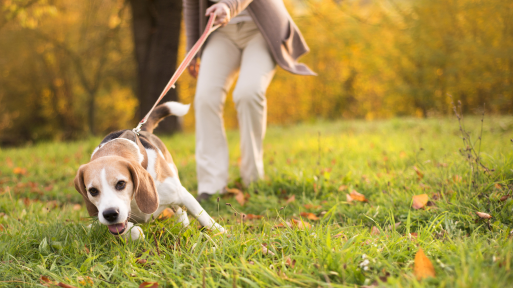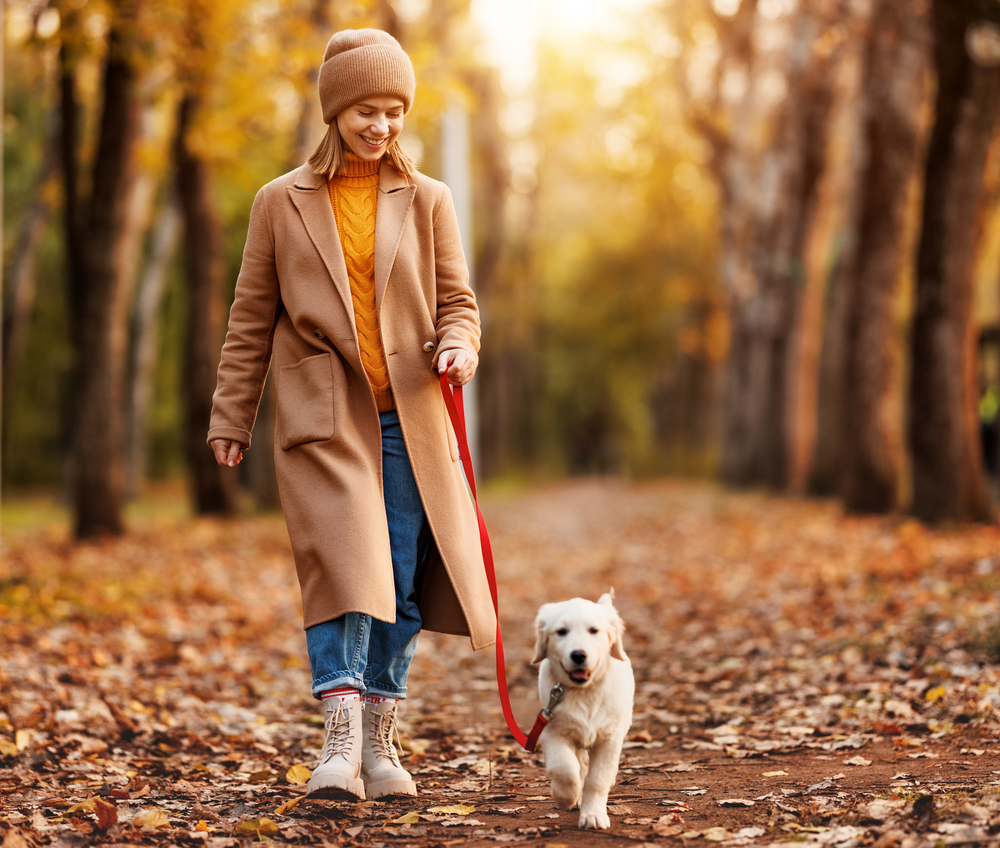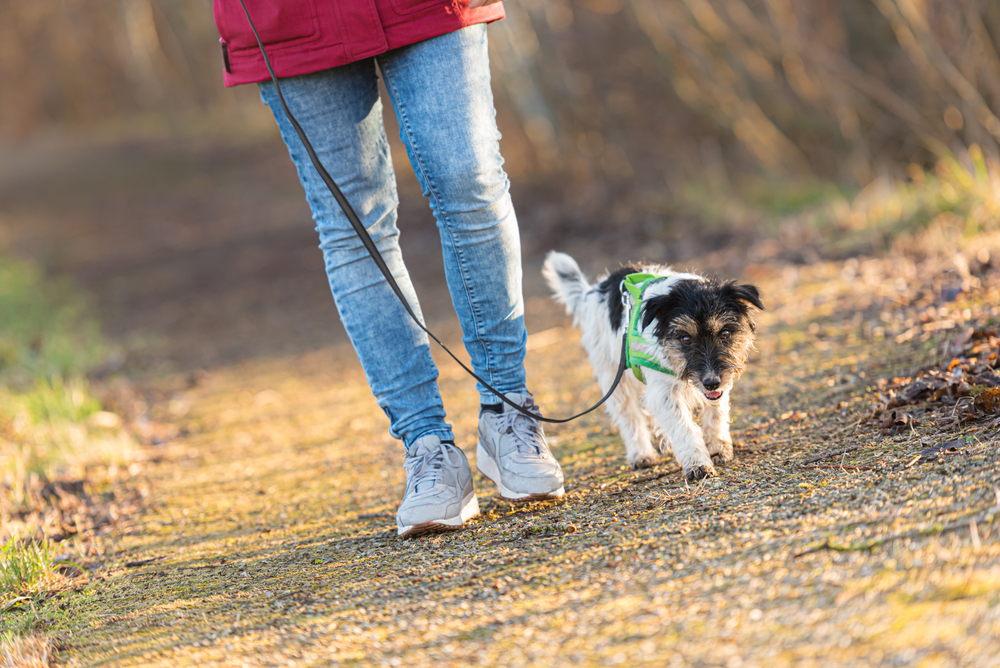Are you tired of your dog pulling on the leash during walks? Are you looking for a way to make your walks more enjoyable and stress-free? Look no further than learning these Loose Leash Dog Training techniques. With these proven methods, you can master the art of walking your dog on a loose leash, promoting better bonding and reducing stress for both you and your furry companion.

Loose Leashes Dog Training focuses on teaching dogs to walk on a leash without pulling. By using positive reinforcement and teaching your dog to ignore distractions, you can achieve loose leash walking behaviors. With dedicated practice and the right tools, such as a treat pouch, collar, and clicker, your dog can learn to walk nicely on a leash and exhibit loose leash walking behaviors.
Key Takeaways:
- Loose Leashes Dog Training can help you teach your dog to walk on a leash without pulling.
- Positive reinforcement and teaching your dog to ignore distractions are key elements of Loose Leashes Dog Training.
- Using the right tools, such as a treat pouch, collar, and clicker, can aid in achieving loose leash walking behaviors.
- By mastering loose leash walking, you can have more enjoyable walks and strengthen the bond between you and your dog.
- Enrolling in professional dog training classes can provide guidance and support in mastering loose leash walking techniques.
Understanding Loose Leash Walking
Before diving into training tips, it’s important to fully grasp the concept of loose leash walking
Definition, Characteristics and Why It Matters
Loose leash walking means your dog chooses to walk attentively by your side without pulling on the leash. There is always slack in the leash. Your dog regularly checks in with you without prompts. This makes walks controlled, calm and connected.

Natural Tendencies: Why Dogs Tend to Pull on The Leash
Dogs pull due to excitement, distraction or desire to explore. Breed traits, inadequate exercise and using the leash for control can also cause it. Pulling self-rewards by allowing the dog to get where they want faster. They learn to tune you out. This must be corrected through training.
Advantages and benefits of Mastering Loose Leash Walking
- Strengthens your leadership and enhances your dog’s respectful behavior.
- Lets you control the walk’s pace, route, and experiences.
- Reduces leash tangles, tripping hazards, and pulling.
- Prevents neck strain or trachea damage from tension on the leash.
- Fosters attention and bonding between you and your dog.
- Generalizes to good manners in other areas, such as greetings.
- Promotes better obedience, focus, self-control, and impulse management.
- Provides a more enjoyable walking experience.
- Helps your dog ignore distractions and remain calm in various environments.
- Lays the foundation for successful training in other areas.
Preliminary Training Considerations
Before you begin leash training, some key factors determine your approach and establish realistic expectations.
Factors Determining the Leash Training Duration
- Your dog’s age, energy level and prior training
- Frequency and length of daily training sessions
- Level and types of distractions in training environments
- Consistency in techniques and communication
- Innate traits like breed, stubbornness and excitability
Setting and Managing Realistic Expectations for Training Progress
- Significant progress can take weeks or months depending on the dog
- There will be ups and downs – expect setbacks and plateaus
- Manage frustrations by celebrating small successes
- Advanced skills like off-leash reliability take much longer
- Maintain realistic outlook to avoid disappointment
Importance of Individual Time Commitment and Experiences
- Training sessions should occur daily for 10-20 minutes
- Each dog learns at a different pace depending on past experiences
- Bonding during walks makes training more effective
- Training individually prevents dogs distracting each other
- Consistency, patience and positivity are vital
Choosing The Side for Your Dog and Holding The Leash Correctly
- Most owners train their dog to walk on their left side
- Hold the leash in your right hand with excess wrapped around left hand
- Don’t hold taut – keep slack except when preventing pulling
- Adjust length so dog walks close without stepping on leash
Essential Tools for Loose Leash Walking
When it comes to mastering loose leash walking, having the right tools can make all the difference. These essential items will help you effectively train your dog and create a positive walking experience for both of you.
Treat Pouch
One of the key tools for loose leash walking is a treat pouch. This handy accessory allows you to conveniently carry and access treats during your training sessions. By rewarding your dog with treats for walking nicely on a loose leash, you can reinforce the desired behavior and motivate your furry friend to continue exhibiting good leash manners.
Analyzing Treat Pouch Options and Their Effectiveness
- Treat pouches worn on waist or shoulder provide easy access to rewards
- Look for pouches with separate compartments to organize treats
- Hands-free pouches allow delivering treats quickly without fumbling
The Pivotal Role Treats Play in The Training Journey
- High-value treats like real meat are more motivational for dogs
- Treat frequency is gradually reduced as the dog masters skills
- Treats should be soft and chewable for easy delivery during motion
- Portion treats into small pieces – training sessions use lots of treats!
Collars
Choosing the right collar is crucial for successful loose leash walking. Collars, such as prong and e-collars, can provide better communication between you and your dog. It’s important to select high-quality collars from reputable brands like Herm Sprenger and E-Collar Technologies to ensure safety and effectiveness. These collars can help you maintain control and guide your dog during walks, promoting better leash manners.
Clicker
A clicker is another invaluable tool for loose leash walking. It allows you to mark and reinforce desired behaviors instantly. By clicking and rewarding your dog for walking on a loose leash, you can communicate clearly and encourage your furry companion to continue exhibiting the desired behavior. The clicker provides a consistent and distinct sound that helps your dog understand when they’re doing something right.
Biothane Leash
A biothane leash is a durable and practical option for loose leash walking. These leashes are lightweight, waterproof, and easy to grip, making them comfortable for both you and your dog. A biothane leash provides a secure connection between you and your furry friend, allowing you to maintain control while giving them some freedom to explore their surroundings.
By utilizing these essential tools, you can set yourself and your dog up for success in loose leash walking. Remember, consistency and positive reinforcement are key components of effective training, so be patient and persistent as you work towards mastering this skill.
Selecting The Ideal Collar and Leash for Clear Communication with Your Dog
- Flat collars in nylon or leather offer control without constricting like choke collars
- Adjust fit so only two fingers slide between collar and dog’s neck
- Leashes should be 4-6 feet long. Retractable leashes teach pulling.
- Opt for thick, durable leash materials like nylon or leather
Emphasis on The Significance of Clickers, Biothane Leashes, and Humane Equipment
- Clickers precisely mark desired behavior for clear communication
- Biothane leashes are vegan-friendly, weatherproof and easy to clean
- Always prioritize equipment that is comfortable and humane
- Never use pain, fear or physical punishment in training
Benefits and Uses of Chest-Led Harnesses and Canine Head Collars
- Harnesses reduce neck strain from pulling without pain
- Head collars allow control of the dog’s head/mouth movements
- These tools maintain control if training goals are not met yet
The Concerns and Drawbacks of Using Choke and Prong Collars
- Choke collars tighten on the dog’s neck when they pull, causing pain/damage
- Prong collars have metal spikes that pinch the dog’s neck
- Both work through pain/fear, often increase aggression in dogs
- Positive reinforcement training is more effective long-term
| Training Methods | Effectiveness |
|---|---|
| Positive Reinforcement | Highly effective in encouraging desired behavior and creating positive associations with loose leash walking |
| Punishment-based methods | Less effective and can lead to fear, anxiety, and aggression in dogs |
| Combination of training techniques | Can be effective when used correctly and tailored to your dog’s individual needs |

Structured Walks for Loose Leash Walking
A “structured walk” refers to a walk where the dog is guided to maintain a specific position, usually beside or slightly behind the handler, with minimal distractions, ensuring focused attention and reinforcing desired behaviors.
Structured walks are an essential component of loose leash walking training. By implementing a structured approach, you can teach your dog to walk with purpose, maintain focus, and exhibit good behavior during walks. Structured walks are not just about exercise; they serve as a platform for reinforcing obedience, improving self-control, and strengthening the bond between you and your furry companion.
During a structured walk, it is important to establish yourself as the leader and maintain control of the walk. Start by setting a consistent pace and ensuring that your dog is walking calmly by your side. Avoid allowing your dog to sniff, mark, or greet others, as these behaviors can lead to pulling and distractions.
To conduct a structured walk effectively, minimize distractions at first by practicing indoors. As your dog becomes more comfortable and familiar with the routine, gradually transition to outdoor environments where there may be more stimuli. Remember to be patient and consistent in your training, as it may take time for your dog to adjust to the structured walk concept.
Benefits of Structured Walks
Structured walks offer numerous benefits for both you and your dog. Walks with purpose and structure help to establish and reinforce your role as the leader, which can contribute to better overall obedience and respect from your dog. Additionally, structured walks provide mental stimulation for your dog, as they need to focus on following your lead and maintaining self-control.
By incorporating structured walks into your loose leash walking training, you are setting your dog up for success in various other training areas. The skills and behaviors learned during structured walks can carry over into daily life, promoting good behavior not only during walks but also in other situations and environments.
| Benefits of Structured Walks | Summary |
|---|---|
| Promotes obedience | Establishes you as the leader and reinforces good behavior. |
| Improves focus and self-control | Helps your dog learn to ignore distractions and maintain attention. |
| Strengthens the bond between you and your dog | Enhances the relationship and communication between you. |
| Transfers to other training areas | Skills learned during structured walks can be applied in various situations. |
Structured walks are a valuable tool in loose leash walking training. They provide the structure, guidance, and reinforcement needed to teach your dog to walk calmly on a loose leash. Remember to approach structured walks with patience, consistency, and a positive mindset, and you will be well on your way to mastering loose leash walking with your dog.
Techniques for Loose Leash Walking
When it comes to teaching your dog to walk on a loose leash, there are several effective techniques you can use. These techniques aim to encourage your dog to stay focused on you and walk calmly without pulling. By combining these techniques with positive reinforcement, you can effectively train your dog to exhibit loose leash walking behaviors.
The Stop and Be Still Technique
The Stop and Be Still technique is a simple yet powerful method for teaching your dog to walk on a loose leash. Whenever your dog pulls on the leash, stop walking and stand still. Wait for your dog to relax and release tension on the leash, showing focus on you. Once the leash is loose and your dog is calm, continue walking. By consistently practicing this technique, your dog will learn that pulling on the leash does not get them anywhere, while walking calmly by your side leads to forward movement and rewards.
The Reverse Direction Technique
The Reverse Direction technique is another effective way to discourage your dog from pulling on the leash. When your dog starts pulling, instead of resisting, immediately turn and walk in the opposite direction. This sudden change in direction interrupts your dog’s forward momentum and teaches them that pulling leads to going the opposite way. After a few steps, turn back in the original direction and continue walking. Repeat this technique as necessary to reinforce loose leash walking behavior.
Vary the Picture
Varying the picture is a technique that helps keep your dog engaged and attentive during walks. Instead of walking in a straight line, change directions unpredictably. This requires your dog to pay attention to you and follow your lead. You can turn left, turn right, or even do a circle. Switch randomly between normal speed, slow pace and quick acceleration. Apply gentle pressure when they pull then release it when leash loosens
By consistently varying the picture, your dog will learn to focus on you and be more aware of your movements, resulting in better loose leash walking skills.
Remember, it’s important to always use positive reinforcement when practicing these techniques. Reward your dog with treats, praise, or a clicker when they exhibit loose leash walking behaviors. This positive feedback will reinforce their good behavior and motivate them to continue walking on a loose leash.
Overcoming Challenges in Loose Leash Walking
While loose leash walking can be a rewarding experience, some dogs may face challenges along the way. Two common challenges that dog owners may encounter are leash reactivity and excitability. Leash reactivity refers to a dog’s heightened response to stimuli, such as other dogs or strangers, while on a leash. This can lead to pulling, lunging, or barking. Excitability, on the other hand, is when a dog becomes excessively excited or hyperactive during walks, making it difficult to maintain a loose leash.
To overcome leash reactivity, it is important to desensitize the dog to triggers and gradually expose them to the source of their reaction in a controlled environment. This can be done by maintaining distance from the trigger and rewarding the dog for calm behavior. Counterconditioning techniques, such as associating triggers with positive experiences, can also help change the dog’s emotional response. For more severe cases, seeking guidance from a professional trainer or behaviorist may be beneficial.
When dealing with excitability, it is essential to provide mental and physical stimulation before walks to help reduce excess energy. Implementing structured exercises or obedience training sessions can help redirect the dog’s focus and promote self-control. Additionally, using tools like chest-led harnesses can provide better control and prevent pulling. Consistency and patience are key when addressing excitability, as it may take time for the dog to learn and adapt to a calmer walking behavior.
| Challenge | Techniques for Overcoming |
|---|---|
| Leash Reactivity | – Desensitization – Counterconditioning – Professional guidance |
| Excitability | – Mental and physical stimulation – Structured exercises – Chest-led harnesses |
Remember that every dog is unique, and what works for one may not work for another. It is essential to understand your dog’s individual needs and tailor the training approach accordingly. With consistency, patience, and the right techniques, you can overcome the challenges of leash reactivity and excitability, and successfully achieve loose leash walking.
How to Reinforce and Maintain The Loose Leash Behavior Over Time
- Schedule refresher sessions in low distraction areas
- Frequently reinforce checking in and slack leash with praise
- If pulling recurs, return to basics – reward every few steps
The Progression: Increasing Steps Between Treats and Using Verbal Cues
- Gradually reward every 2 steps, then 3 etc. until giving treats is unpredictable
- Add clear verbal marker for desired behavior like “good loose leash!”
- Mix reward types – praise, treat, stopping to sniff etc.
Transitioning to Relaxed Walking and Introducing the “Off-Duty” Concept
- Now focus on maintaining consistent loose leash without hyper-vigilance
- Let your dog sniff more – mark and reward slack leash moments
- Use an “off-duty” command to indicate relaxation and freedom
Gradual Reduction in Treat Dependence and Mastering Walking in Different Environments
- Slowly shift to rewarding with praise and letting dog lead more
- Practice in pet stores, downtown, trails etc. without relying on treats
- Bring treats just in case but continue reinforcing real-life behavior
Advice Against Common Mistakes and The Downside of Constant Corrections
- Don’t use physically punitive tools or let frustration set in
- Over-correcting can instill anxiety and damage your bond
- Some pulling is normal! Be realistic.
Seeking Expertise and Additional Resources
If you need additional help, don’t reinvent the wheel. Seek professional expertise tailored to your dog.
Exploring Professional Dog Training Courses and Sessions
- Group classes allow socialization but may be distracting
- Private sessions address unique challenges and breed traits
- Look for certified, positive reinforcement-based trainers
- Ask trusted vets, shelters and breeders for recommendations
Connecting With Behavior Experts for Personalized Guidance and Advice
- Certified applied animal behaviorists (CAAB) offer science-based expertise -They determine motivations behind behaviors and create customized plans
- Useful for resolving issues like reactivity, fear and aggression
Conclusion
Loose leash walking is a valuable skill that can greatly enhance the walking experience for both you and your dog. By consistently applying the right techniques and using the necessary tools, you can teach your dog to walk on a loose leash and exhibit good behavior during walks.
Not only does loose leash walking make walks more enjoyable, but it also promotes better bonding between you and your furry friend. Through positive reinforcement and teaching your dog to ignore distractions, loose leash walking can contribute to improved obedience and overall well-behaved dogs.
With patience, practice, and dedication, any dog can master loose leash walking. Remember to use treats or praise as positive reinforcement, and be consistent in your training efforts. By investing time and effort into teaching your dog this skill, you can enjoy stress-free strolling with your well-behaved companion.
FAQ
What is Loose Leashes Dog Training?
Loose Leashes Dog Training is a method that focuses on teaching dogs to walk on a leash without pulling.
Why is loose leash walking important?
Loose leash walking makes walks more enjoyable and promotes better bonding and reduced stress.
What tools do I need for loose leash walking?
Essential tools include a treat pouch, collar, clicker, and biothane leash.
How can structured walks help with loose leash walking?
Structured walks require the dog’s full attention and the handler’s leadership, contributing to better obedience and focus.
What techniques can I use for loose leash walking?
Techniques include Stop and Be Still, Reverse Direction, and Vary the Picture, accompanied by positive reinforcement.
How can I overcome challenges in loose leash walking?
Overcoming challenges may require additional training, professional guidance, and specialized equipment for specific issues like leash reactivity or excessive excitability.






